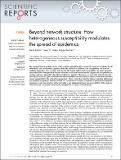Beyond network structure: How heterogeneous susceptibility modulates the spread of epidemics
Author(s)
Smilkov, Daniel; Kocarev, Ljupco; Hidalgo Ramaciotti, Cesar A.
DownloadSmilkov-2014-Beyond network structure.pdf (526.7Kb)
PUBLISHER_CC
Publisher with Creative Commons License
Creative Commons Attribution
Terms of use
Metadata
Show full item recordAbstract
The compartmental models used to study epidemic spreading often assume the same susceptibility for all individuals, and are therefore, agnostic about the effects that differences in susceptibility can have on epidemic spreading. Here we show that–for the SIS model–differential susceptibility can make networks more vulnerable to the spread of diseases when the correlation between a node's degree and susceptibility are positive, and less vulnerable when this correlation is negative. Moreover, we show that networks become more likely to contain a pocket of infection when individuals are more likely to connect with others that have similar susceptibility (the network is segregated). These results show that the failure to include differential susceptibility to epidemic models can lead to a systematic over/under estimation of fundamental epidemic parameters when the structure of the networks is not independent from the susceptibility of the nodes or when there are correlations between the susceptibility of connected individuals.
Date issued
2014-04Department
Massachusetts Institute of Technology. Media Laboratory; Program in Media Arts and Sciences (Massachusetts Institute of Technology)Journal
Scientific Reports
Publisher
Nature Publishing Group
Citation
Smilkov, Daniel, Cesar A. Hidalgo, and Ljupco Kocarev. “Beyond Network Structure: How Heterogeneous Susceptibility Modulates the Spread of Epidemics.” Sci. Rep. 4 (April 25, 2014).
Version: Final published version
ISSN
2045-2322